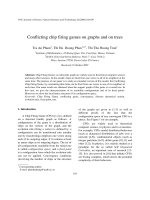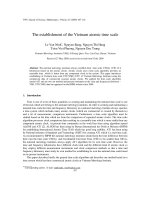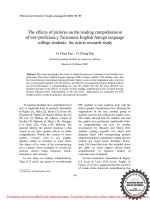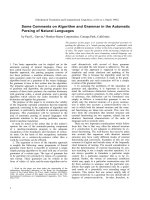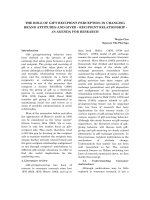Báo cáo " The impact of environment on morphological and physical indexes of Vietnamese and South Korean students " docx
Bạn đang xem bản rút gọn của tài liệu. Xem và tải ngay bản đầy đủ của tài liệu tại đây (137.88 KB, 6 trang )
VNU Journal of Science, Natural Sciences and Technology 24 (2008) 50-55
50
The impact of environment on morphological and physical
indexes of Vietnamese and South Korean students
Mai Van Hung*, Sunyoung Pak
Seoul National University, Korea
Received 25 October 2007
Abstract. Researches were carried out on 916 male students and 910 female Korean students at
the age of from 20 to 25 in Seoul National University, South Korea. The results show that in
general, the basic morphological and physical indexes of students of South Korea are
approximately equal to the average standard of the world’s youth now and the Korean students
have anthropometric indexes better than Vietnamese students. For reasons that effect to
anthropometry index of South Korean students, except for the influences of genetic, endocrine and
race. The environment, including Location, Geography, & Climate, regimen, Psychology, Physical
exercise, etc., are important factors which have effects on health, and morphology and physical
status of students.
1. Introduction
*
Most of the previous researches showed that
the values of morphological and physical
indexes are influenced by the environment. H.
Nygard et al, studied on the musculoskeletal
capacity of employees from 44 to 58 in
physical, mental and mixed types of work in
European [1]. Sunnegardh and E. Bratterby
have found that the maximal oxygen uptake,
anthropometry and physical activity of 8 and 13
years old children in Sweden [2], the Midtby et
al, study on the variation in bone formation
markers with age, gender, anthropometry and
season in both men and women [3]. Ritsuko
Imamura et al studied on effects of wearing long
and mini-skirt for a year on subcutaneous fat
thickness and body circumference [4]
Annie C. Wetter and Christina D. Economos,
study on the skeletal status in young adulthood
______
*
Corresponding author. Tel.: 84-0211-863202.
E-mail:
may require more specific moderate to vigorous
physical activity [5]. Roderic Floud, John
Komlos, Richard Steckel and Kenneth Sokoloff
have studied economic welfare index by human
stature have shown that height, at maturity is a
reliable proxy indicator of health and nutritive
condition and that socioeconomic factor as well
as hereditary, environmental factor affects the
growth of height. Lauderdale DS and Rathouz
PJ study on the effects of nativity, years since
immigration and socioeconomic status on
dimensional body is importance [6].
In Vietnam, there have been many research
projects on these problems; for example:
“Vietnamese’ physiologic constants in 1975”
by Nguyen Tan Gi Trong et al [7],
“Vietnamese’ Anthropometry in 1990”,
“Project KX 07-07 in 1994”, “Atlats
Vietnameses’ Anthropometry in 1985” or the
surveys conducted in some areas, provinces,
schools, colleges, universities by other
physiology scientists. Some other researches
M.V. Hung, P. Sunyoung / VNU Journal of Science, Natural Sciences and Technology 24 (2008) 50-55
51
done at a smaller level are “Proposal of new
indexes and classification of robusticity of
Vietnamese adults” by Le Gia Vinh, Vo Hung
et al, “Morphological human races and physical
of Ede’s males in Tay Nguyen” by Mai Van
Thin, “Some morphological and physical
indexes of learners of Thanh Hoa Teachers
Training College” by Mai Van Hung, “ The
indexes of morphological human races and
physical of north Vietnam people adults ‘90” by
Trinh Van Minh, Tran Sinh Vuong et al, “A
survey of human races of youth and students”
by Le Nam Tra et al,.[8] Most of the previous
researches showed that the values of
morphological and physical indexes are
influenced by the environment especial “the
values of Vietnamese’ biology in ’90
th
century
XX” by Ministry of Health, Vietnam [9] .
2. Objectives
Form and physical force are the important
indexes from to assess health status. They show
a part of actual body status and the relationship
between human physiology and environmental
factors such as climate, season, nutrition,
activities, economy, urbanization, and stress.
Most of the previous researches showed that the
values of morphological and physical indexes
are influenced by the environment.
Therefore, the purpose of this research is to
identify environmental factors that effect to
anthropometry of Korean students from there to
find out the marked differences between
anthropometric indexes of Korean students and
Vietnamese students, at the same time to
explain why the South Korean people got
anthropometric index are better than
Vietnamese’s in recent decades.
3. Method
Researches were carried out on about 1000
male students and 1000 female Korean students
aged 20-25 years old volunteered to be the
research objects. All of them haven’t suffered
from malformation or chronic diseases in Seoul
National University (Period: from 9/2006 to
6/2007). After then comparison of basic
anthropometric indexes of Korean students and
Vietnamese students (other our study in
Vietnam before)
- Using the method of Martin and M.F.
Ashley Montagu’s method was used to measure
Morphological indexes. This is a cross -
sectional study. Every subject had been tested
on the height, weight, measurement of middle
chest (chest girth). The average values of the
indexes were calculated based on the Button’s
formula.
4. Findings
Result
1. The reality of basic anthropometric
indexes of Korean students
This description is based on 916 males and
910 females.
Table 1. Average basic anthropometric indexes of Korean students (X + SD)
No Index Male (n= 916) Female (n=910)
1. Height (cm)
174.51 ± 6.15 161.22 ± 5.18
2. Weight (kg)
69.56 ± 5.45 57.43 ± 4.12
3. Measurement of middle chest (cm)
91.62 ± 5.11 83.78 ± 7.87
4. Pignet
13.56 ± 5.75 21.43 ± 6.22
5. BMI
23.15 ± 1.79 22.26 ± 1.36
M.V. Hung, P. Sunyoung / VNU Journal of Science, Natural Sciences and Technology 24 (2008) 50-55
52
Table 1 shows average some
anthropometric base indexes of males and
females. The males’ indexes of height, weight,
measurement of middle chest, are higher than
the females’ (p < 0.01). This result shows the
characteristics of sex.
2. The reality of basic anthropometric
indexes of Vietnamese students
This description is based on 1000 males and
1000 females.
Table 2. Average basic anthropometric indexes of Vietnamese students (X + SD)
No Index Male (n = 1000) Female (n=1000)
1. Height (cm)
165.76 ± 6.55 155.22 ± 5.32
2. Weight (kg)
53.62 ± 5.54 46.75 ± 4.67
3. Measurement of middle chest (cm)
79.81 ± 5.46 72.53 ± 6.29
4. Pignet
32.39 ± 3.26 35.97 ± 6.38
5. BMI
19.88 ± 1.96 19.56 ± 1.67
Table 2 shows average some
anthropometric base indexes of males and
females. The males’ indexes of height, weight,
measurement of middle chest, are higher than
the females’ (p < 0.01). This result shows the
characteristics of sex. However, there is not
much difference between females and males of
Vietnamese students as between females and
males of Korean students.
3. Comparison of basic anthropometric
indexes of Korean students and Vietnamese students
Average basic anthropometric indexes of
Korean students and Vietnamese students are
presented in Table 3 and Table 4.
Table 3. Average basic anthropometric indexes of males of Korean students and Vietnamese students (X + SD)
No Index Korean (n=916) Vietnamese (n=1000)
1. Height (cm)
174.51 ± 6.15 165.76 ± 6.55
2. Weight (kg)
69.56 ± 5.45 53.62 ± 5.54
3. Measurement of middle chest (cm)
91.62 ± 5.11 79.81 ± 5.46
4. Pignet
13.56 ± 5.75 32.39 ± 3.26
5. BMI
23.15 ± 1.79 19.88 ± 1.96
As shown in the above table, there was
significant difference in the average basic
anthropometric indexes of males such as height,
weight, and so on between Korean students and
Vietnamese student. Most of these indexes of
Korean students are better than Vietnamese
students.
Table 4. Average basic anthropometric indexes of females of Korean students and Vietnamese students (X + SD)
No Index Korean (n=910) Vietnamese (n=1000)
1 Height (cm)
161.22 ± 5.18 155.22 ± 5.32
2 Weight (kg)
57.43 ± 4.12 46.75 ± 4.67
3 Measurement of middle chest (cm)
83.78 ± 7.87 72.53 ± 6.29
4 Pignet
21.43 ± 6.22 35.97 ± 6.38
5 BMI
22.26 ± 1.36 19.56 ± 1.67
M.V. Hung, P. Sunyoung / VNU Journal of Science, Natural Sciences and Technology 24 (2008) 50-55
53
The data are presented in Table 4. There
was significant difference in the average basic
anthropometric indexes of females such as
height, weight, and so on between Korean
students and Vietnamese student. Most of these
indexes of Korean students are better than
Vietnamese students.
5. Discussion
Average male height in Vietnamese and
North Korean remains comparatively small at 5
ft 4 in (1.63 m) and 5 ft 5 in (1.65 m)
respectively. Currently, young North Korean
males are actually significantly shorter. While
average male height in South Koreans are about
3 inches (8 cm) taller than their North Korean
counterparts, on average. The difference
between South Koreans, and even older North
Koreans, compared to young North Koreans
who grew up during the famine of the 1990s-
2000s is extraordinary [10]. Thus, except for
the influences of genetic and endocrine,
especially regimen on human growth, we believed
that The environment including many factors as
Location, Geography, & Climate, regimen,
Psychology, Physical exercise and so on are
importance reasons as well which have influenced
on students’ health, and morphology and physical
status of them
Our study also showed that anthropometry
indexes of Korean students are better than
Vietnamese students. Thus, why the basic
anthropometry indexes of students of
Vietnamese are smaller than the average
standard level of students in the world,
especially the average standard level of Korean
students?
The location, geography, and climate: The
marked difference of the location, geography,
and climate between Korea and Vietnam, we
believed that these different conditions have
effect on human variation in body size and shape.
The amount of habitual physical activity has
no effect on body height, but daily caloric
expenditure can be a major determinant of
weight. Increased physical activity or training
can result in diminished levels of body fat and
increased muscle mass, Bone mineralization
responds directly to physical stressors, and
some evidence indicates that adults who are
more active are at less risk for osteoporosis.
According to this theory, the different physical
activity or training has effect on human
variation in body size and shape adaptation to
the different environment. Thus, characteristics
distinguish of geography the Vietnam from the
Korea shown us that these conditions can be
different determinant of physical activity or
training. Therefore, they have different effects
on basic anthropometric indexes of human as
height, weight index and so on.
The effects of climate on human variation
in body size and shape conform to ecological
‘ruler’ of mammalian biological adaptation to
the thermal environment. In hot environment,
excess body heat produced by mammalian
metabolism and voluntary muscular activity
must be dissipated to the environment to avoid
hyperthermic stress. Such loss many occur by
radiation (direct transfer of infra-red energy
from the body to a cooler object), conduction
(heat exchange by direct physical contact
between the body and cooler object), conviction
(heat exchange between the body and a cooler
object via an intermediary medium, e.g.air
flow), or evaporation (conversion of water, e.g.
perspiration, to vapor using body heat).
Relatively low body weight, or body volume,
and relatively large body surface area, produced
by having legs and arms relatively long in
proportion to the size of the trunk of the body,
assist in heat loss. Low body volume decreases
the amount of metabolizing tissue, and also
decreases the distance required for the radiation
of heat from the internal organs and muscles to
the surface of the body. Large body surface area
increases the potential for convection,
conduction, and evaporation. In cold
environments, a relatively large body volume
and small surface area (i.e., relatively short
M.V. Hung, P. Sunyoung / VNU Journal of Science, Natural Sciences and Technology 24 (2008) 50-55
54
extremities in proportion to trunk size) is the
body type best suited for heat retention. Body
fatness, especially the thickness of the
subcutaneous fat layer, may also increase in
cold environments. Adipose tissue is relatively
inert metabolically, due to poor vascularization,
and acts as an insulating barrier against heat
loss by radiation. In hot environments, a thin
subcutaneous layer of fat helps minimize heat
retention [11].
Thus, generally the basic anthropometric
indexes of the North people are higher than the
South people. For example: Europeans in North
America were far taller than those in Europe in
the eighteenth and nineteenth centuries, in fact
the tallest in the world. The original indigenous
population was also among the tallest
populations of the world at the time. However,
several nations, indeed many nations in Europe,
have now surpassed the US in terms of average
stature, particularly the Netherlands, and the
Scandinavian nations. Most markedly is the
Netherlands where average height has increased
at the greatest rates. The Netherlands was in the
late nineteenth century a land renowned for its
short population, but today it has the tallest
average in the world, with young men
averaging 1.83 m tall and only shorter than the
peoples of the Dinaric Alps, where males
average 1.856 m tall. The Dutch are now well
known in Europe for extreme tallness.
From the data about location and climate
above and Barry Bogin’s [11] study explain
that, the Korean people have living belong
among the North Asia people (around 37
o
North), during the Vietnamese people belong
among the South Asia people (around 16
o
North). Therefore, the basic anthropometric
indexes of Vietnamese people are not higher as
Korean people.
About specific regimen of Korean: South
Korea is one of the developed countries in the
world while Vietnam is a developing country.
This different is main cause effect on the
quality and quantity of food everyday in this
country and other, so this gives a different role
to nutrition in developed countries compared
with developing countries. For example, the
food value of nutrition in developed countries is
better than in developing country.
Psychological influences on human
growth: In general, from after the War 1950 -
1953 to now, Korean’s social environment have
been peace and stable which is importance to
establish Korean’s psychosocial environment.
While, before 1975 Vietnam were put on a war
footing. From 1976 up to now, Vietnam has
been peace and stable. In Vietnam, the highest
increase occurs from 1975 to 1985 due to not
only secular trend but also due to "catch - up".
An explanation for this is that before 1975
when the Vietnam was in the war time, living
conditions were poor and the environment was
polluted. After that, living conditions were
improved, which have led to rapid growth of
human body (called catch - up). However,
Vietnam is still poor country in the world.
Additionally, the country continues to
experience protests from various groups, so
Vietnamese’s psychosocial environment is
worse than Korean’s psychosocial environment.
So, might be this is one of causes that
influenced the anthropometric indexes of
Vietnamese students bad to day.
Physical exercise of Korean students:
Physical exercise is important for maintaining
growth body and can contribute positively to
maintaining a healthy weight, building and
maintaining healthy bone density, muscle
strength. Exercise has been shown to improve
cognitive functioning via improvement of
body’s morphology and physiology, and
enhancement of actively life. In addition,
physical activity has been shown to be change
anthropometric indexes. Our investigation in
the Sport centre, SNU, showed that there are
many modern instruments of sports indoor and
outdoor. These are good conditions help
students have for a practice everyday these
modern instruments have not any universities in
Vietnam now.
M.V. Hung, P. Sunyoung / VNU Journal of Science, Natural Sciences and Technology 24 (2008) 50-55
55
6. Conclusions
For the reality of anthropometry index of
South Korean students: Basic morphological
and physical indexes of students of South Korea
are approximately equal to the average standard
of the world’s youth now and the Korean
students have anthropometric indexes better
than Vietnamese students. For example, the
height of South Korean students averaging
174.51 cm (male) and 161.22 cm (female) while
the height of Vietnamese students averaging
165.76 cm (male) and 155.22 cm (female).
Except for the influences of genetic,
endocrine and race on effect to anthropometry
index of South Korean students. The
environment including many factors as
Location, Geography, & Climate, regimen,
Psychology, Physical exercise and so on are
importance reasons as well which have
influenced on students’ health, and morphology
and physical status of them.
References
[1] H. Nygard, et al., Musculoskeletal capacity of
employees aged 44 to 58 years in physical, mental
and mixed types of work, European Journal of
Applied Physiology, Volume 56, Number 5/
September (1987) 75.
[2] Sunnegardh., E. Bratterby, Maximal oxygen
uptake, anthropometry and physical activity in a
randomly selected sample of 8 and 13 year old
children in Sweden”, European Journal of Applied
Physiology-Volume 56, Number 3/May (1987) 7.
[3] M. Midtby, J.H. Magnus, R.M. Joakimsen, The
Tromsø Study: A Population-Based Study on the
Variation in Bone Formation Markers with Age,
Gender, Anthropometry and Season in both Men
and Women, Journal of Osteoporosis
International, Volume 12, Number 10/October,
(2001) 42.
[4] Ritsuko, Imamura et al., Effects of wearing long
and mini-skirt for a year on subcutaneous fat
thickness and body circumference. The 5
th
Asian
conference on clothing study, November 6 -7
th
,
Thailand, 1999, 58.
[5] Annie, C. Wetter., Christina, D. Economos,
Relationship between quantitative ultrasound,
anthropometry and sports participation in college
aged adults, Journal of Osteoporosis
International, Volume 15, Number 10/ October,
(2004) 26.
[6] DS. Lauderdale, P.J. Rathouz, In a US national
sample of Asian Americans: effects of nativity,
years since immigration and socioeconomic
status. Department of Health Studies, University
of Chicago, IL 60637, USA
[7] N.T.G. Trong, et al., Vietnameses’ physiologic
constants, Hanoi Medical Publishing House,
1975, 44 pp
[8] L.N. Tra, et al., Project on a basic census of
Vietnameses’ anthropometry in 1990, Hanoi
Medical Publishing House, 1996
[9] L.N. Tra, et al., The values of Vietnamese’ biology
in ’90
th
century XX”, Published by Hanoi
University of Medicine, 2003.
[10] The Seattle Times: “Short stature evident in North
Korea generation”
[11] Barry, Bogin., Patterns of Human growth.
Cambridge University press, 1999.
Ảnh hưởng của môi trường lên các chỉ số hình thái và thể lực
của sinh viên Việt Nam và Hàn Quốc
Mai Văn Hưng, Sunyoung Pak
ðại học Quốc gia Seoul, Hàn Quốc
Nghiên cứu ñược thực hiện trên 916 sinh viên nam và 910 sinh viên nữ tuổi từ 20 ñến 25 thuộc
trường ðại học Tổng hợp Quốc gia Seoul, Hàn Quốc. Kết quả nghiên cứu cho thấy, các chỉ số nhân
trắc cơ bản của sinh viên Hàn Quốc xấp xỉ mức trung bình của sinh viên thế giới và tốt hơn sinh viên
Việt Nam. Ngoại trừ các nguyên nhân về gen, nội tiết và chủng tộc. Các yếu tố môi trường như ñiều
kiện ñịa lý, khí hậu, dinh dưỡng, tâm lý xã hội, rèn luyện thân thể…cũng có vai trò vô cùng quan trọng
ảnh hưởng ñến các chỉ số nhân trắc này.
